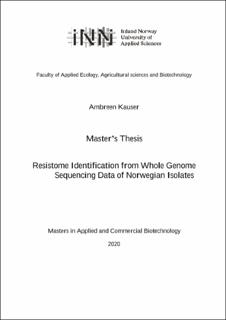| dc.description.abstract | Antimicrobial resistance (AMR) is considered a potential threat to global health. Norway have had a low prevalence of resistant bacteria. But in the recent years there has been an increase in resistant bacteria including, Escherichia coli, Klebsiella pneumoniae and Acinetobacter baumannii. Traditionally, clinical microbiology has used culture-based techniques to determine antimicrobial susceptibility and resistance profiles, but now whole–genome sequencing for antibiotic susceptibility (WGS-AST) has emerged as a potential alternative.
We aimed to investigate the prevalence of antimicrobial resistance genes and plasmids in WGS of 111 clinical Norwegian isolates of E. coli, K. pneumoniae, and A. baumannii, to identify correlations between phenotypic and genotypic resistance in the isolates, which are related to antibiotic resistance to β-lactam, aminoglycosides, fluoroquinolone, trimethoprim, tetracycline, and phenicol.
The most occurring drug class was β-lactam antibiotic with TEM (38%) in E.coli, SHV (67%) in K. pneumoniae, and OXA (100%) and TEM (45%) gene families in A. baumannii. In silico detection of plasmids with Brooks et al database showed plasmid p2_000837 as prominent plasmid 12% E.coli isolates. There were four plasmids (pIB_NDM_1, p2_W5-6, pCHL5009T-102k-mcr3, pVir_020022) in 2% K. pneumoniae isolates which were also shared with E. coli. Only one plasmid (pHZ23-1-1) was confirmed in 9% of A. baumannii isolates. PLSDB detected Plasmid A and plasmid 4 with the maximum percentage in E.coli (10%) and K. pneumoniae isolates (4%). In E. coli and K. pneumoniae, the presence of incompatibility groups was observed; IncFIB (64% and 27%), Col156 (74% and 27%), IncFII (43% and 15%), while IncHI-1B(pNDM-MAR) (12%) were present only in K. pneumoniae .
A total of 75 isolates had resistance to the tested β-lactam antibiotics, out of which 63 had the corresponding resistance genes (ampC, SHV, CTX-M, TEM, LEN, OXA). Only 11 E.coli and one K. pneumoniae isolates were found to have resistance genes and the plasmids on the same node to confirm plasmid mediated resistance.
This study demonstrates the utility of WGS in defining resistance elements and highlights the diversity of resistance within the selected isolates to further the diagnostics and therapeutics for the treatment of the relevant infections. | en_US |
